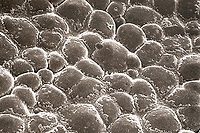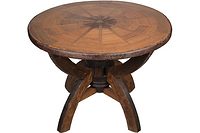Conversion coatings imbue metals with special properties, such as corrosion and wear resistance, paint receptivity, or aesthetic effects. These treatments are generally straightforward to implement and open up a plethora of new applications. However, because of the chemical nature of the process, there are caveats to conversion coating that are important to understand.
What Is Conversion Coating?
In conversion coating, the outer surface of a metal part chemically transforms into an oxide layer. In contrast with electroplating, or passive coatings such as spray paints, direct-to-metal (DTM), coil coating, physical vapor deposition (PVD), and powder coating, the newly formed surface is integral to the part. The treatment results in enhanced mechanical properties and durability.
Conversion coating is basically a form of controlled rusting. The superior mechanical properties it provides to the base metal are similar to what is achieved in the production of weathered or COR-TEN steel. COR-TEN steel was invented to reinforce railroad hopper cars, and it remains popular for architecture and artworks.

The most common methods of conversion coating are:
- Anodizing
- Alodining
- Passivation
- Black oxide
The following are the details of each process.
Anodizing
Anodization, or eloxation, involves the electrolytic passivation of aluminum that is submerged in a 15% sulphuric acid solution. The part forms an anode where a layer of aluminum oxide builds up on the outer surface. At the same time, the oxidation grows down into the part to an equal degree. So a 2 μm coating will increase dimensions by 1 μm, and parts have to be toleranced accordingly.
During the process, parts are suspended on conductive racks, leaving rack marks where the solution does not come in contact with the part. To control the location of rack marks, contact your supplier.
Dyeing and infusion of corrosion inhibitors is an optional next step. A wide spectrum of colors is available, yet light colors are difficult to produce, reds and blues tend to fade over time, and black may turn out gray on thinner coatings.
Inorganic colorants produce the most lightfast colors such as black and gold, but they can also be the least ecologically sensitive.
When investing in a chemical process at mass-manufacturing scale, some knowledge of organic chemistry can help in planning operations and concurrent waste management.
After dyeing, remaining nanopores are filled using hydrothermal nickel-acetate sealing. The increased hardness by several factors, together with its lustrous sheen and light weight makes anodized aluminum a sought-after material for consumer electronics, medical devices, tools, wheel hubs, bicycle frames, flashlights, architectural facades, and structural frames in space.
According to military-grade specifications, there are three types of anodization:
- Type I. Using chromic acid results in a thinner coating which is better for fatigued components such as aircraft fuselages.
- Type II. Most common type with coat thicknesses of 5-30 μm.
- Type III. Ceramic-like hardcoat of 25-100 μm.
A drawback of Type I anodization, or the Bengough-Stuart process, is that it involves hexavalent chromium, a known carcinogen and environmental pollutant. This substance is used in lead chromate pigments in the red-yellow color space used for inks, paints, and plastic products made with injection molding.
Heightened cost is a disadvantage of Type III anodization because of higher voltages and increased process control in terms of solution temperature, acidity, concentration, and current.
Due to its brittleness, thicker coatings are prone to cracking induced by thermal stresses or fatigue. Sharp corners are to be avoided, with the minimum edge fillet radius being 31 x the anodic layer thickness. Polytetrafluoroethylene (PTFE) sealing results in the smoothest parts.
In Type III coatings over 75 μm, abrasion resistance drops significantly. Alloys containing over 2% copper are also less wear-resistant, and 6061 is generally the most suitable type of aluminum, surpassing 2000 or 7000 series grades.
Anodized parts adhere excellently to paint, so this is a popular post-process, along with laser etching and pad printing. In addition to aluminum, the process can be applied to titanium, tantalum, magnesium, and zinc.

Alodine
Better known as chromate conversion coating, chem film, or Iridite, Alodine results in the thinnest coatings of 0.25-1 μm. It is often used for fasteners like screws, bolts, and brackets because no additional geometric dimensioning and tolerancing (GD&T) is required.
Since no electrolysis takes place the process is cheaper but also results in less durable coatings. As opposed to anodizing, Alodine results in better electrical conductivity. As a dual finish, anodization can follow Alodine to further enhance corrosion resistance in places where tolerances are irrelevant.
A greenish gold sheen can be achieved but the process releases chromium 6 as a byproduct, which can seep into bodies of water and be hazardous to fish. So to help phase out hexavalent chromium and improve sustainability, opt for the clear variant.
Black Oxide
Colloquially known as bluing or browning, black oxide applies to steel and stainless steel, enhancing its corrosion resistance. The cost-effective finish results in a matte black look because of chemical baths converting the surface into magnetite. An oil or wax sealing further adds lubriciousness.
Passivation
Steel passivation is generally understood to be a synonym for conversion coating, despite there being different kinds. In one version of the process, the high chromium content of stainless steel reacts with oxygen to form a protective barrier.
In another variant called phosphate conversion coating, phosphoric acid and salts are applied to the part to sheathe it with a durable metalophosphate microcoating 5-15 μm in thickness. The nanopores are then covered with a manganese or zinc seal, a process known as parkerization. The final result is a smooth and glossy part that is now “passive.” In other words, it is unaffected by environmental influences.
Final Takeaway
Through-and-through conversion coatings are the superior choice to passive coatings that adhere to a part’s outer surface without any structural chemical bond. Conversion coatings are corrosion and wear resistant while improving suitability for painting and impregnation. Still, there are substantial differences in cost, mechanical properties, visual aesthetics, and environmental impact between the various processes.

Anodizing truly glamorizes a product, making it attractive for a mainstream audience. Unique looks for architectural buildings can be achieved that emulate bronze, gold, copper, or brass. Plus it’s fairly harmless to the environment and free of volatiles (VOCs).
When developing new products, include conversion coating choices in the early stage of color-material-finish (CMF) specification and take into account the corresponding guidelines presented here for spectacular results.





Report Abusive Comment